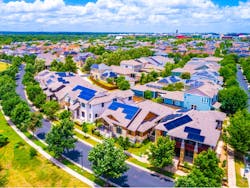Solar and storage provider Sunrun has proposed creating neighborhood microgrids that would allow for resilience and energy sharing within “distribution islands.”
The company released a paper intended to encourage utilities and other stakeholders to consider reconfiguring the grid into distribution circuits that can be islanded.
Under the proposal, many but not all homes on the circuit would be equipped with solar and storage whose energy could be shared among neighbors, said Audrey Lee, vice president, energy services, Sunrun. In addition, the company envisions battery storage located at neighborhood substations that could help blackstart the grid after an outage.
Sunrun wants to collaborate with utilities and other stakeholders on the proposal and find a way to reconfigure the grid, Lee stressed.
“Imagine a future with high penetrations of rooftop solar and batteries. Not every home can have solar and storage. We would need a flexible grid to share the resources,” she said.
Never been done before
“This has never been done before; we want to get everyone together to do this.” Utilities could play a central role in coordinating and managing the distribution islands.
The paper is aimed in part at solving some of the immediate fire-related challenges California is now experiencing, but the distribution islands could serve other communities.
Paul Doherty, a spokesman for Pacific Gas & Electric (PG&E), said the company is looking at SunRun’s proposal.
“PG&E is continuously looking to work with stakeholders to find safe and efficient solutions to address the increasing frequency of catastrophic wildfires and reduce the frequency and scope of Public Safety Power Shutoff events,” said Doherty. “We are evaluating Sunrun’s proposal to understand its technical feasibility.”
Sunrun’s Lee responded, “We stand ready to collaborate with PG&E and other utilities to advance clean, resilient energy solutions to help safeguard communities against blackouts.”
The proposal would leverage the fact that, especially in California, more and more homeowners are adding solar and storage to their roofs. These systems would become part of the neighborhood circuits.
In the future, Sunrun expects much higher penetrations of rooftop solar and storage, said Lee. This creates an opportunity for homeowners and businesses to have backup power and share it with their neighbors, she said.
Inside neighborhood microgrids
Right now, customers of Sunrun’s BrightBox solar plus storage systems can island individually from the grid. But there’s no way for homes and businesses behind substations to island together during outages. And there’s no way for solar and storage owners to share with neighbors the energy they produce.
“We imagine high penetration of solar and batteries, a lot of generation,” said Lee.
In addition, a small battery at the substation would be needed to help blackstart the circuit after an outage.
Homeowners and businesses wouldn’t be required to purchase the company’s BrightBox system, but would choose their own systems.
To realize Sunrun’s idea, switchgear would be needed to allow substations to disconnect from the grid and create an island, said Lee.
“Instead of shutting down a distribution line, a substation would be shut down. But it’s not the usual utility business model to do this.”
Source: Sunrun report, “Smart, Clean Neighborhood Grids“
Next steps?
Regulators would need to develop standards and regulations to help realize the goal of the project. These would help ensure that solar and storage from different manufacturers could all operate in the neighborhood grid.
In addition, it would be necessary to create a market for the power in each neighborhood. That market would determine how to share energy among neighbors.
During normal operations when the neighborhoods aren’t disconnected from the grid, the solar plus storage could be aggregated into a virtual power plant, which SunRun has done in the past.
Sunrun also envisions having the neighborhood grids use utility distribution. To accomplish this, it would be necessary to eliminate some existing distribution boundaries.
“There’s an artificial demarcation of the customer meter,” said Lee. “We need to remove the artificial boundary so energy can be shared when needed.”
It would also make sense to provide incentives for customers to acquire solar plus storage, especially in California, where wildfire season is just around the corner, she said.
Sunrun seeks industry feedback
“Wildfires in California aren’t going away. The urgency of the situation means incentives to speed deployment.”
Sunrun is anxious to hear what regulators, utilities and other stakeholders have to say about its proposal, and acknowledges that the company is not a technical expert on the grid.
“We didn’t try to hammer out the exact solution in the paper,” said Lee. “We are the experts in working with customers and understanding what customers want. We’re not experts in running the grid.”
Track innovations in energy like neighborhood microgrids. Subscribe to the free Microgrid Knowledge newsletter.








